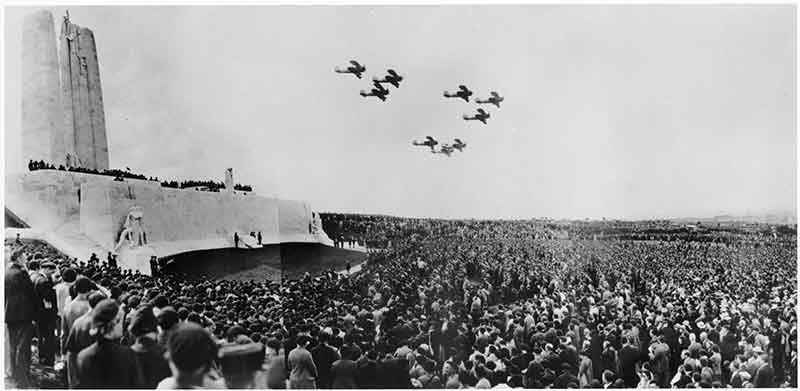Curious about the history behind the Vimy Memorial? Look no further than Veterans Affairs Canada, who have meticulously curated the answers to the questions so many students raise when learning the intricate details of WWI and Canada’s consequential role. Below is just a small sample of the information readily available on their resource center.
The Battle of Vimy Ridge
The Canadian assault at Vimy—part of the larger Battle of Arras in northern France—began on Easter Monday, April 9, 1917. All four divisions of the Canadian Corps, made up of soldiers from coast to coast, would fight together for the first time there. Advancing behind a powerful “creeping barrage” laid down by the Allied artillery, our men captured most of the ridge by noon on the battle’s first day, with the last German resistance being overcome by April 12. The Battle of Vimy Ridge was one of the most successful Allied offensive operations to that point in the war and saw the capture of more ground, enemy artillery pieces and prisoners than any previous action by British or Canadian forces.
A monumental idea
The scale of the Canadian service and sacrifice during the First World War was unprecedented and the end of the conflict was accompanied by a strong public sentiment that it must never be forgotten.
It was decided that Canada would have eight official sites overseas to commemorate our most significant battles. Memorials at St. Julien, Hill 62 (Sanctuary Wood) and Passchendaele would be created in Belgium. Courcelette, Le Quesnel, Dury, Bourlon Wood and Vimy Ridge would be the sites for the memorials in France.
A public contest was held in the early 1920s to select the design for the Canadian monuments and it was ultimately decided that the ambitious proposal submitted by Walter Seymour Allward would be chosen for Canada’s primary First World War memorial at Vimy Ridge.
From the beginning, Allward’s vision for the monument at Vimy was to be a synthesis of art and remembrance. Its location is integral to its power as it stands on the hallowed ground where our soldiers sacrificed and achieved so much in April 1917. On some 107 hectares of land that the grateful people of France had granted to Canada after the war, the beautiful Canadian National Vimy Memorial rises from atop the highest point of the ridge, offering visitors breathtaking panoramic views. Much of the surrounding terrain was left largely untouched, making it one of the largest preserved First World War battlefields on the former Western Front. The site is crisscrossed with former trench lines, pockmarked with countless shell craters and undermined with old tunnels, making it a true glimpse into the past.
It would take eleven years to build the monument which rests on a bed of 11,000 tonnes of concrete, reinforced with hundreds of tonnes of steel. It is clad with almost 6,000 tonnes of light-coloured limestone which came from an ancient quarry on the Adriatic Sea. When the memorial was officially dedicated by King Edward VIII in July 1936, a huge crowd was in attendance which included thousands of Canadian Veterans who had made the long trip back to France.
We’re expecting another huge crowd, some 22,000+ visitors, to surround the monument, once again ready to commemorate the historic battle and remember the honourable men and women who died to provide our freedom.
For more information about the Vimy Memorial, visit the Veterans Affairs Canada fact sheet.

